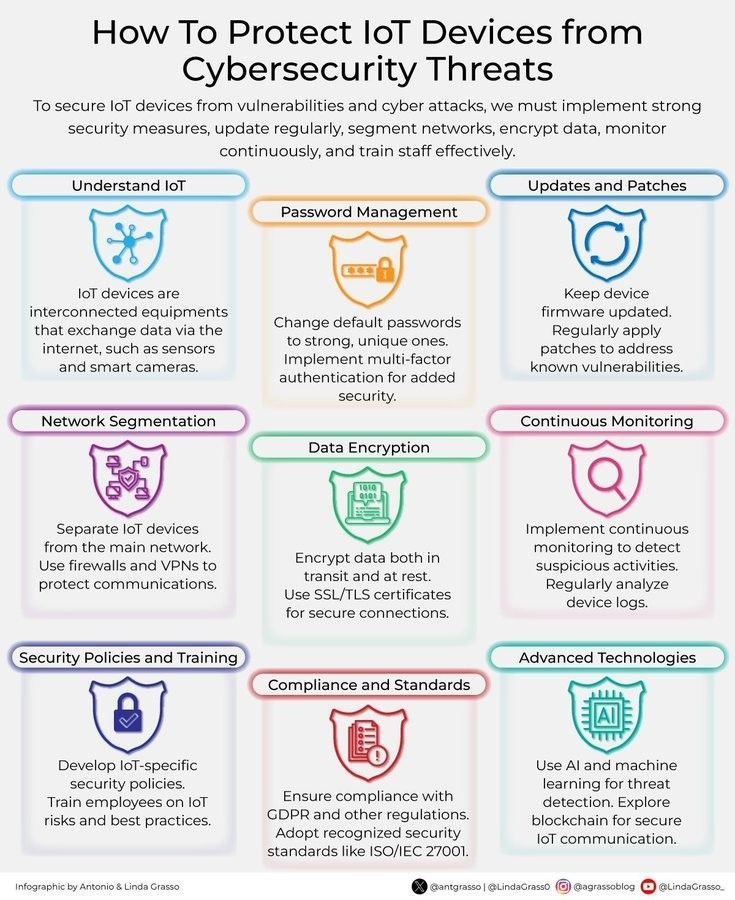The Internet of Things (IoT) has revolutionized the way we interact with technology, providing unprecedented convenience and connectivity. However, this interconnectedness also brings significant cybersecurity risks. Protecting IoT devices from cybersecurity threats is crucial to maintaining privacy and security in our increasingly digital world. This article explores various strategies to safeguard IoT devices from cyber threats.
Understanding the Risks
IoT devices are susceptible to a wide range of cyber threats, including malware, phishing, and identity theft. The sheer number of connected devices creates a vast attack surface for cybercriminals. According to the Zscaler ThreatLabz 2024 Mobile, IoT, and OT Threat Report, the United States alone accounts for 81% of global IoT cyberattacks. This highlights the urgent need for robust cybersecurity measures.
Best Practices for IoT Security
1. Secure Network Connections
One of the primary steps in protecting IoT devices is ensuring secure network connections. Use strong, unique passwords for Wi-Fi networks and enable encryption protocols such as WPA3. Additionally, consider setting up a separate network for IoT devices to isolate them from other critical systems.
2. Regular Software Updates
Keeping IoT devices updated with the latest firmware and software patches is essential. Manufacturers often release updates to address security vulnerabilities. Automakers, for instance, need to enhance the safety of vehicles with over-the-air software updates to prevent hacking, as highlighted in a recent article by Mint on the cybersecurity risks associated with connected cars.
3. Strong Authentication Mechanisms
Implementing strong authentication mechanisms, such as multi-factor authentication (MFA), can significantly enhance IoT security. MFA requires users to provide multiple forms of verification before accessing a device, making it more challenging for unauthorized users to gain access.
4. Network Segmentation
Network segmentation involves dividing a network into smaller segments, each with its own security controls. This limits the spread of malware and restricts unauthorized access to sensitive information. For example, segmenting IoT devices from critical infrastructure can prevent widespread disruptions in case of a cyberattack.
5. Device Encryption
Encrypting data transmitted between IoT devices and servers ensures that even if data is intercepted, it remains unreadable to unauthorized parties. Encryption is a fundamental aspect of protecting sensitive information and maintaining privacy.
6. Regular Audits and Monitoring
Conducting regular security audits and monitoring network traffic can help identify and mitigate potential threats. Automated tools and artificial intelligence (AI) can assist in detecting unusual patterns and responding to security incidents in real-time.
Case Studies and Real-World Examples
Smart Cars at Risk
The automotive industry has seen a surge in connected vehicles, which are vulnerable to cyberattacks. A cybersecurity expert highlighted the risks of vehicle hacking through over-the-air updates, emphasizing the need for automakers to enhance security measures.
Electric Toothbrushes in Cyber Attacks
In a surprising turn of events, hackers used compromised electric toothbrushes in a massive cyberattack, resulting in significant financial loss for a Swiss company. This incident underscores the importance of robust cybersecurity measures for all IoT devices, regardless of their perceived insignificance.
Traffic Light Controllers
Researchers discovered vulnerabilities in traffic light controllers that could allow hackers to create traffic jams. This finding highlights the potential for cyberattacks to disrupt critical infrastructure and emphasizes the need for stringent security protocols.
The Role of AI in IoT Security

Artificial Intelligence (AI) plays a crucial role in enhancing IoT security. AI-powered solutions can analyze vast amounts of data to detect anomalies and respond to threats in real-time. Companies like Exein are leveraging AI to secure industrial IoT devices, preventing dangerous situations and ensuring the safety of employees and production lines.
Government and Industry Collaboration
Addressing IoT cybersecurity requires collaboration between governments and industry stakeholders. The telecom industry, for example, must unite to protect users by sharing information and developing comprehensive solutions to combat cyber threats.
Conclusion
Protecting IoT devices from cybersecurity threats is a multifaceted challenge that demands a proactive approach. By implementing best practices, leveraging AI, and fostering collaboration between governments and industry, we can safeguard our interconnected world from the ever-evolving landscape of cyber threats.

Check out more AI tools.
Elevate Guest Experience with RoomGenie
Textify Analytics – Affordable Insights at the Speed of AI
